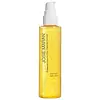What's inside
What's inside
 Key Ingredients
Key Ingredients

 Benefits
Benefits

 Concerns
Concerns

No concerns
 Ingredients Side-by-side
Ingredients Side-by-side

Water
Skin ConditioningGlycerin
HumectantDecyl Glucoside
CleansingDisodium Coco-Glucoside Citrate
EmulsifyingDisodium Cocoyl Glutamate
CleansingPolyglyceryl-10 Laurate
Skin ConditioningXanthan Gum
EmulsifyingPhenoxyethanol
PreservativeSaccharide Isomerate
HumectantCoco-Glucoside
CleansingGlyceryl Oleate
EmollientSodium Lauroyl Lactylate
EmulsifyingParfum
MaskingArgania Spinosa Kernel Oil
EmollientSodium Cocoyl Glutamate
CleansingAloe Barbadensis Leaf Juice
Skin ConditioningAlthaea Officinalis Root Extract
Skin ConditioningAnanas Sativus Fruit Extract
Skin ConditioningEthylhexylglycerin
Skin ConditioningLactic Acid
BufferingCitric Acid
BufferingSalix Alba Bark Extract
AstringentLactobacillus Ferment
Skin ConditioningSodium Citrate
BufferingPotassium Sorbate
PreservativeSodium Benzoate
MaskingTocopherol
AntioxidantHydrogenated Palm Glycerides Citrate
EmollientWater, Glycerin, Decyl Glucoside, Disodium Coco-Glucoside Citrate, Disodium Cocoyl Glutamate, Polyglyceryl-10 Laurate, Xanthan Gum, Phenoxyethanol, Saccharide Isomerate, Coco-Glucoside, Glyceryl Oleate, Sodium Lauroyl Lactylate, Parfum, Argania Spinosa Kernel Oil, Sodium Cocoyl Glutamate, Aloe Barbadensis Leaf Juice, Althaea Officinalis Root Extract, Ananas Sativus Fruit Extract, Ethylhexylglycerin, Lactic Acid, Citric Acid, Salix Alba Bark Extract, Lactobacillus Ferment, Sodium Citrate, Potassium Sorbate, Sodium Benzoate, Tocopherol, Hydrogenated Palm Glycerides Citrate
 Reviews
Reviews

Ingredients Explained
These ingredients are found in both products.
Ingredients higher up in an ingredient list are typically present in a larger amount.
Decyl Glucoside is a glucose-based surfactant and emulsion stabilizer. It is created by reacting glucose with the fatty acids from plants.
Surfactants help clean the skin by trapping oil, sebum, and dirt to be washed away. As an emulsion stabilizer, it stabilizes the ingredients in a product by preventing them from separating.
This ingredient is biodegradable and non-toxic. This ingredient is commonly found in baby shampoos.
Decyl Glucoside is sometimes used to stabilize the UV filter Tinosorb.
Learn more about Decyl GlucosideWe don't have a description for Disodium Coco-Glucoside Citrate yet.
Ethylhexylglycerin (we can't pronounce this either) is commonly used as a preservative and skin softener. It is derived from glyceryl.
You might see Ethylhexylglycerin often paired with other preservatives such as phenoxyethanol. Ethylhexylglycerin has been found to increase the effectiveness of these other preservatives.
Glyceryl Oleate is the ester of glycerin and oleic acid. This ingredient is mainly an emollient and emulsifier.
Emollients soften and hydrate the skin by creating a thin film on top to trap in moisture. As an emulsifier, glyceryl oleate helps stabilize formulations by preventing ingredients such as oil and water from separating. According to a manufacturer, this ingredient helps helps thicken water-in-oil formulations, shower gels, and hair shampoos.
In some products, this ingredient may be used as a fragrance / perfuming ingredient. The scent of this ingredient is described to be "waxy".
Glyceryl oleate is created from oils rich in oleic acid, such as peanut oil and olive oil.
This ingredient may not be malassezia folliculitis safe.
Learn more about Glyceryl OleatePotassium Sorbate is a preservative used to prevent yeast and mold in products. It is commonly found in both cosmetic and food products.
This ingredient comes from potassium salt derived from sorbic acid. Sorbic acid is a natural antibiotic and effective against fungus.
Both potassium sorbate and sorbic acid can be found in baked goods, cheeses, dried meats, dried fruit, ice cream, pickles, wine, yogurt, and more.
You'll often find this ingredient used with other preservatives.
Learn more about Potassium SorbateWater. It's the most common cosmetic ingredient of all. You'll usually see it at the top of ingredient lists, meaning that it makes up the largest part of the product.
So why is it so popular? Water most often acts as a solvent - this means that it helps dissolve other ingredients into the formulation.
You'll also recognize water as that liquid we all need to stay alive. If you see this, drink a glass of water. Stay hydrated!
Learn more about WaterXanthan gum is used as a stabilizer and thickener within cosmetic products. It helps give products a sticky, thick feeling - preventing them from being too runny.
On the technical side of things, xanthan gum is a polysaccharide - a combination consisting of multiple sugar molecules bonded together.
Xanthan gum is a pretty common and great ingredient. It is a natural, non-toxic, non-irritating ingredient that is also commonly used in food products.
Learn more about Xanthan Gum